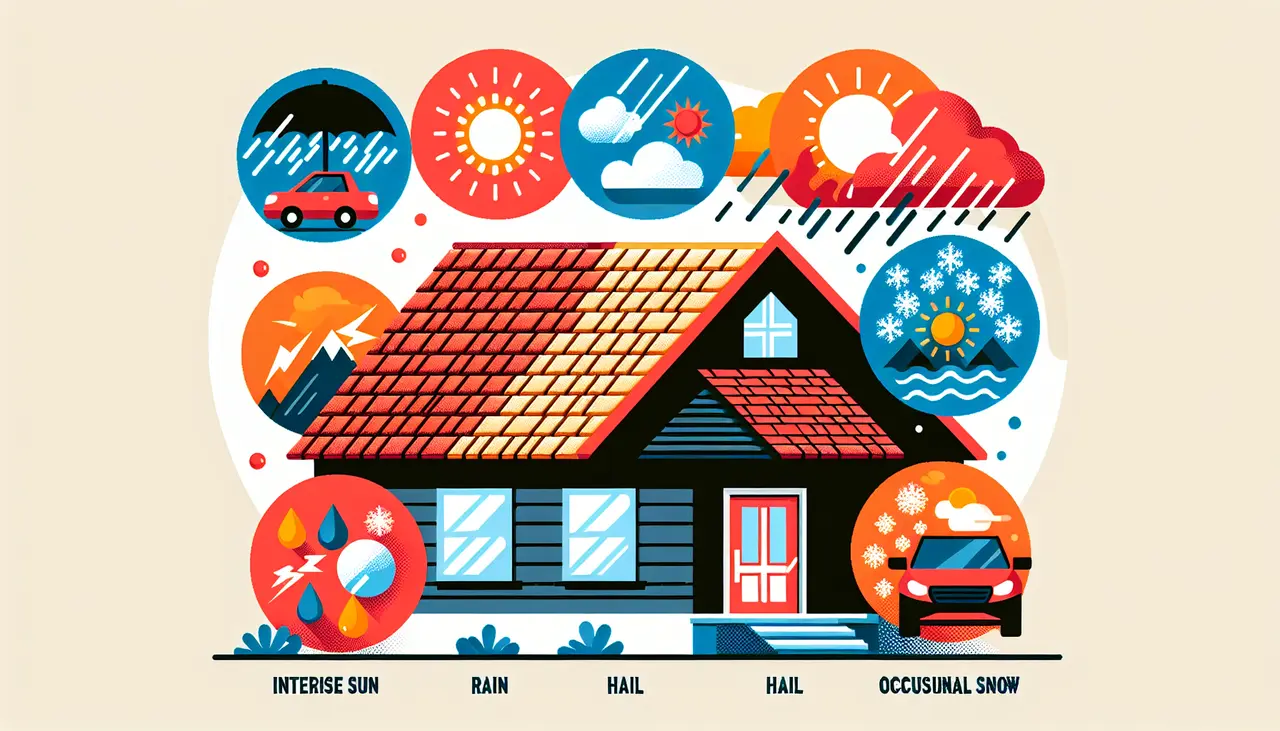Introduction to Central Texas Weather and Your Roof
Central Texas weather is like a roller coaster with no off switch. Picture blazing hot summers, flash thunderstorms, and even the occasional hailstorm all putting your roof to the test. This constant battering by Mother Nature can take a toll on your roof shingles, the protective barrier keeping your home safe and dry. Shingles exposed to the intense sun can crack and fade, while heavy rains and hail can leave them bruised or even missing. It’s a tough gig being a roof in Central Texas. But understanding how the weather affects your roof is the first step to protecting your home. Whether you’re dealing with scorching heat or stormy weather, your roof has to stand guard 24⁄7. The better you know what it’s up against, the better you can prepare.
Types of Weather Impact on Roof Shingles
Central Texas weather throws a lot of curveballs, each affecting your roof shingles in different ways. Let’s break it down, plain and simple.
First up, heat and sun. Think scorching summers. Over time, the intense sun can cause your shingles to crack, warp, or fade. It’s like leaving anything plastic outside—it just doesn’t last.
Next, we’ve got rain and hail. Rain, by itself, isn’t much of a bully, but it’s when it brings hail along that you see the real damage. Hail can dent, crack, or even knock off shingles, leaving your roof vulnerable to leaks.
Don’t forget wind. Strong winds can lift the edges of shingles or rip them off completely. After a heavy storm, it’s common to see shingles missing, especially around the edges or at the ridge.
Lastly, temperature fluctuations. You know how it can be warm one day and freezing the next? These rapid changes can cause shingles to expand and contract, leading to cracking or weakening over time.
In a nutshell, Central Texas weather keeps your roof shingles on their toes, with each element bringing its own brand of trouble. Knowing what you’re up against can help you make the best decisions for maintaining your roof’s health.
Signs That Your Shingles Need Repair Due to Weather Damage
Your roof takes a beating from Central Texas weather. Knowing when your shingles need repair can save you a lot of money and a headache. Look out for these signs: Curling shingles – Excessive heat can make them curl. Missing shingles – Strong winds can tear them away. Granules in gutters – Hail and rain wash away the protective granules. Cracked shingles – Temperature changes can make them brittle and crack. Each of these signs points to weather damage. Ignoring them could lead to bigger issues. Keep an eye on your roof, especially after severe weather events. Early repairs mean a longer life for your roof and fewer worries for you.
The Importance of Timely Shingle Repair
Ignoring damaged shingles can lead to bigger problems. Think about it; your roof’s shingles are the first line of defense against Central Texas’ unpredictable weather. When storms or heavy winds hit, they can tear off or damage your shingles. This leaves your roof vulnerable to water damage, which can seep into your home, causing mold and structural issues. The quicker you fix damaged shingles, the better. It saves you from more costly repairs down the road. Plus, keeping your roof in good shape maintains your home’s value. Consider it this way: a small repair now can prevent a huge headache later. So, don’t put off fixing those shingles. It’s not just about avoiding leaks; it’s about protecting your home and your wallet.
Common Shingle Repair Solutions for Weather Damage
When Central Texas weather hits hard, your roof takes the brunt. Scorching sun, hail, and high winds can tear shingles apart. Luckily, repair solutions are straightforward. For minor damage, roofing cement or a few new shingles usually do the trick. Here’s the deal: if a few shingles are cracked or missing, simply replace them. But, if damage is widespread, you might be looking at a bigger repair job or a full roof replacement. Always check for underlying issues. Sometimes, leaks or rot hide beneath. If you catch damage early, a simple patch-up can save you tons. Don’t wait – regular checks after big storms keep costs down. Remember, ignoring small problems today can lead to giant headaches tomorrow.
How to Protect Your Shingles from Central Texas Weather
Central Texas weather throws a lot at your roof; from scorching sun to hail storms, it’s a battlefield up there. Protecting your shingles isn’t rocket science, but it does need you to pay attention. Start by choosing materials that are fighters; metal, slate, and tiles can take the sun’s punches better than others. Regular checks are your best defense. After big storms or intense heat waves, get up there or have someone skilled take a look. Spotting trouble early can save you a lot of hassle and money. Don’t skimp on maintenance. Clear those gutters, trim the trees, and fix minor damage before it turns into a full-blown disaster. And finally, quality matters. Investing in top-tier shingles and professional installation might hit the wallet initially but consider it armor plating for your home. It’s about fighting smart, not just hard, against Central Texas weather.
DIY vs. Professional Shingle Repair: What You Need to Know
When your roof shingles get battered by Central Texas weather, you might wonder whether to fix them yourself or call a pro. Here’s what you need to know: DIY repair can save money upfront and is doable for minor damages. You’ll need basic tools and a bit of know-how from online tutorials. But, if you mess up, it could cost you more in the long run. Professional repair, while pricier, brings expertise and guarantees the job is done right. They can spot issues you might miss. Think about the repair size and your skill level. For small fixes, DIY could work. But for major damage, it’s wise to trust a pro. Your roof’s health is crucial; choose wisely.
The Cost of Neglecting Shingle Repair in Weather-affected Areas
Ignoring shingle repair in areas hit hard by Central Texas weather can make a small problem a big wallet drainer. When shingles get damaged by hail, heavy rain, or scorching sun, they don’t just look bad, they stop protecting your house. If you let them be, expect more trouble. Water leaks can lead to mold inside your home, damaged ceilings, and a weakened structure. Fix a few shingles early, and you might pay a few hundred dollars. Wait too long, and you could be looking at thousands for a full roof replacement. Also, high energy bills can sneak up on you. Damaged shingles mean your AC or heater works overtime to keep your home comfy. Bottom line, a stitch in time saves nine. Don’t wait for a raindrop to fall on your head to take action.
Maintenance Tips to Extend the Life of Your Shingles
Regular inspection is the first step to extend the life of your shingles. Look for damaged or missing shingles, especially after heavy storms. Replace these immediately to prevent water damage. Keep trees near your house trimmed. Overhanging branches can scratch shingles during winds, leading to wear and tear. Clean your gutters. Clogged gutters cause water buildup and can lead to leaks damaging the roof structure and shingles. Ensure proper ventilation in your attic. Poor ventilation can cause heat buildup, making shingles crack or warp. Lastly, get a professional roof inspection annually. They can spot issues you might miss and advise on maintenance or repairs. Taking these steps will help your shingles withstand Central Texas weather, saving you money on repairs and replacements in the long run.
Conclusion: Staying Ahead of Weather Damage
It’s clear Central Texas weather spares no mercy on roof shingles. The fierce sun, unexpected hail, and howling winds can wear down even the toughest materials. But you’re not helpless. By choosing the right shingles, keeping an eye on your roof’s condition, and acting swiftly at the first sign of damage, you can stay a step ahead. Remember, prevention is cheaper than replacement. Regular inspections, especially after severe weather events, can save you a lot of trouble and money down the line. Don’t let the weather dictate the lifespan of your roof. By being proactive, you ensure your roof stands strong against whatever Central Texas throws at it.







